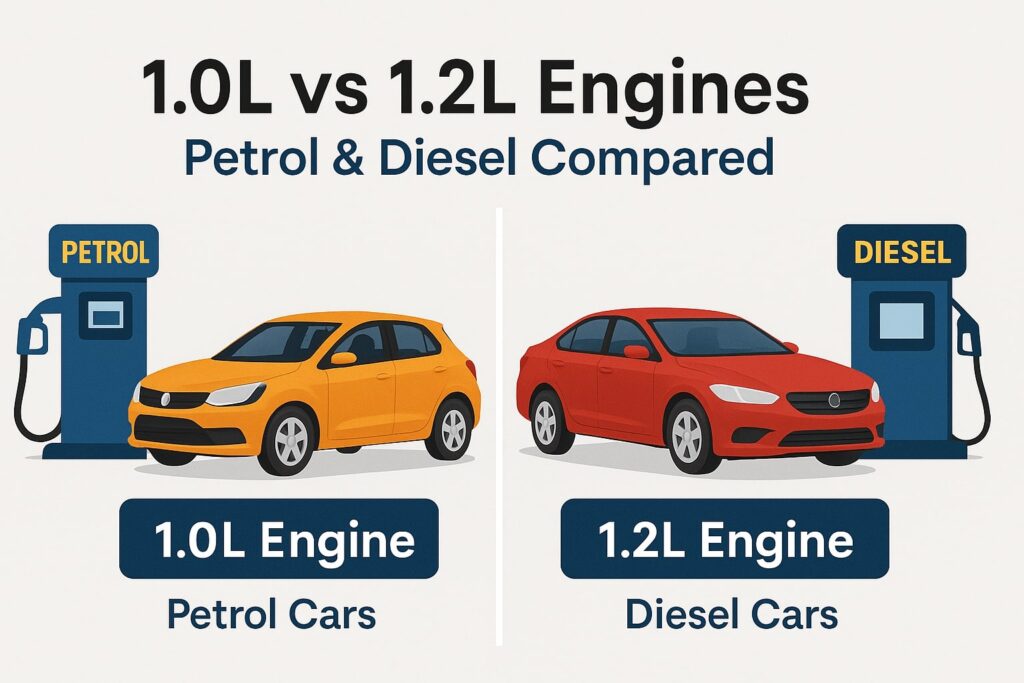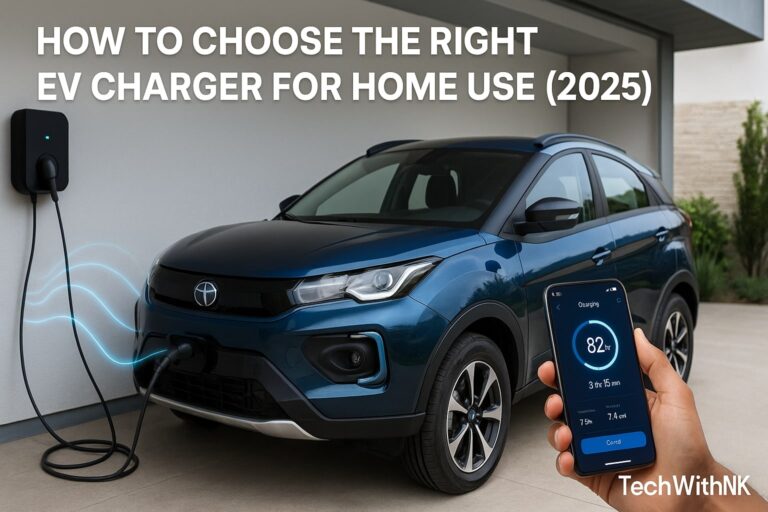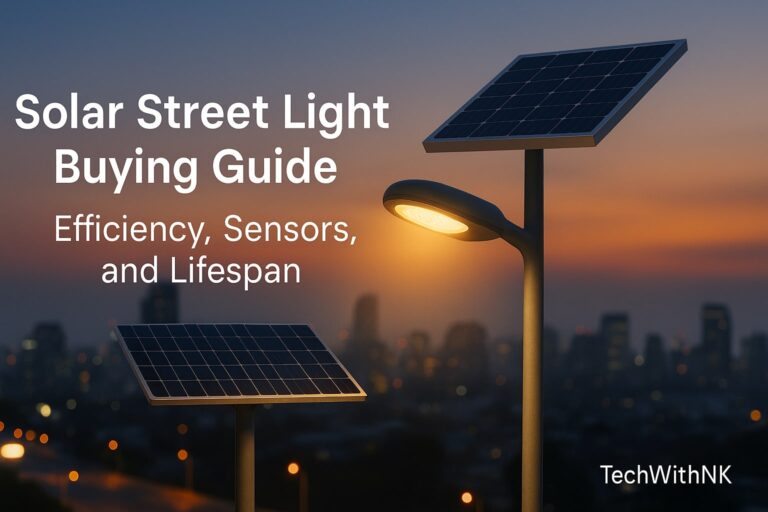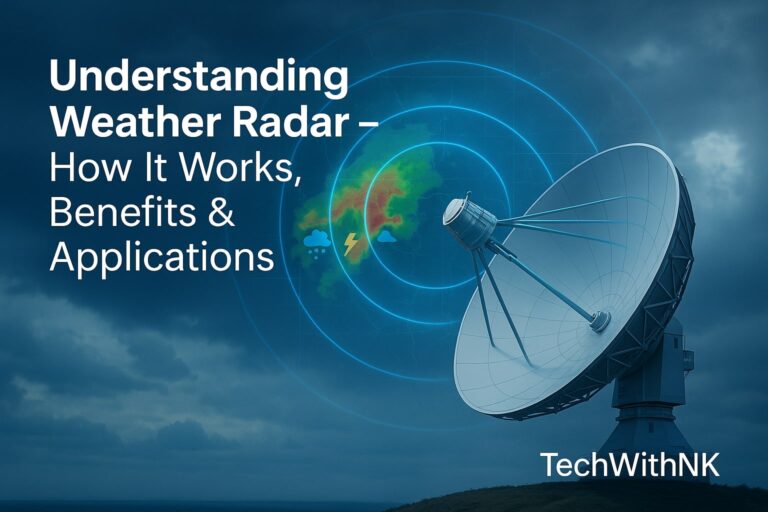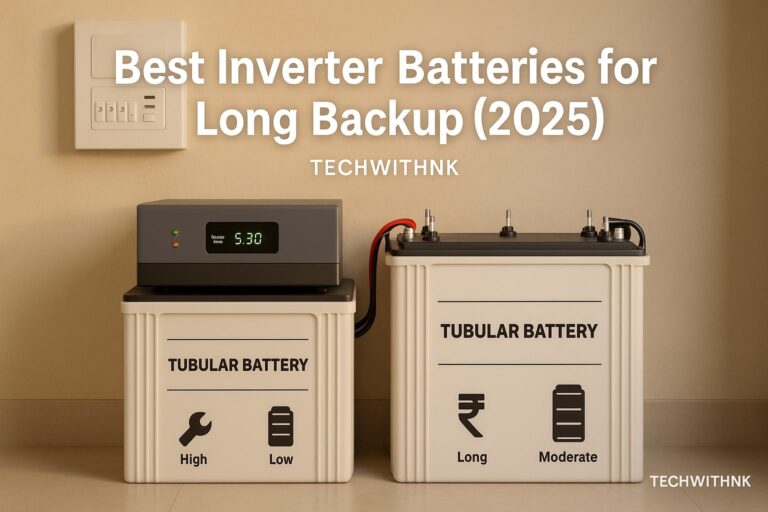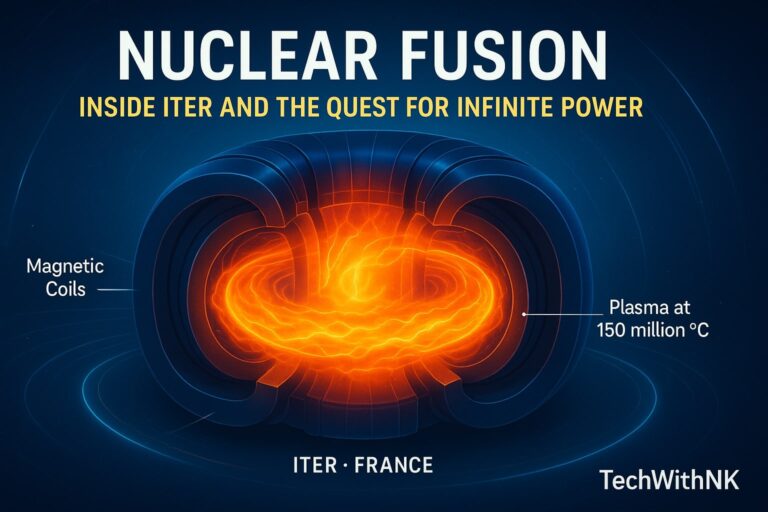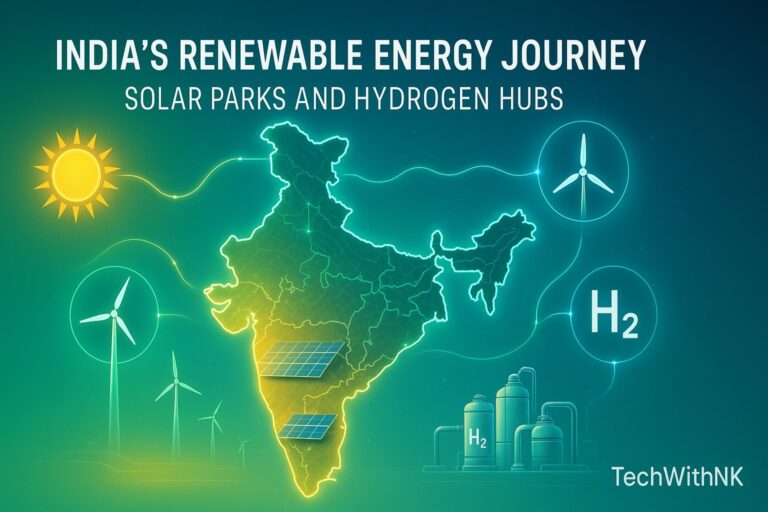🔹 Introduction 1.0L vs 1.2L Engines
When it comes to buying a car in 2025, one of the most common confusions for buyers is choosing the right engine size. In the Indian market, small and mid-sized cars often come with 1.0L and 1.2L engines, both in petrol and diesel options. At first glance, the difference of 200cc may seem minor—but in real-world driving, this small difference can mean a lot in terms of power, torque, mileage, and long-term ownership cost.
Whether you’re a daily city commuter, a highway driver, or someone who wants a balanced family car, understanding the difference between 1.0L and 1.2L engines is essential. In this blog series, we’ll take a deep dive into everything you need to know—from technical differences to fuel efficiency, maintenance, cost, and future prospects.
By the end, you’ll have a clear picture of which engine suits your driving needs better.

🔹 What Does 1.0L or 1.2L Engine Mean?
The “L” in an engine stands for liters, which is the engine displacement—the total volume of all the cylinders inside the engine where the air-fuel mixture burns.
1.0L engine = approximately 1000 cubic centimeters (cc).
1.2L engine = approximately 1200 cc.
👉 That means a 1.2L engine can burn more air + fuel mixture than a 1.0L, producing more power and torque.
To visualize:
A 1.0L engine is like a small water bottle—it carries enough for basic needs.
A 1.2L engine is a slightly larger bottle—more capacity, more output.
Real-life examples in India (2025):
1.0L Petrol cars: Maruti Alto K10, Renault Kwid, Hyundai Exter (turbo option).
1.2L Petrol cars: Maruti Swift, Hyundai i20, Tata Tiago.
1.2L Diesel cars (older models, pre-BS6): Ford Figo, Hyundai Grand i10, Volkswagen Polo.
🔹 Why Engine Size Matters in 2025
Choosing between a 1.0L vs 1.2L engine isn’t just about numbers on paper. It affects:
Acceleration and overtaking ability.
Mileage and fuel cost.
Maintenance expenses.
Resale value.
Driving comfort on highways and hilly terrains.
For instance:
A 1.0L engine may be perfect for city traffic, but it might struggle with fully loaded highway trips.
A 1.2L engine offers better power balance, but it may cost slightly more to buy and maintain.
🔹 Petrol vs Diesel Engines – Quick Refresher
Before diving into the engine size comparison, let’s quickly revisit how petrol and diesel engines differ.
| Factor | Petrol Engine | Diesel Engine |
|---|---|---|
| Ignition | Spark plug ignition | Compression ignition (no spark plug) |
| Efficiency | Lower mileage | Higher mileage |
| Torque | Less pulling power | More torque, better for hills/highways |
| Noise & Vibration | Smooth & quiet | Louder, more vibration |
| Initial Cost | Cheaper cars | More expensive |
| Maintenance | Lower, simpler | Higher, complex (turbo, injectors) |
| Best For | City driving, small families | Long drives, highways, taxis, rural use |
👉 In 2025, petrol engines dominate small car sales because diesel engines have become costlier to manufacture (BS6 norms). However, 1.2L diesel cars are still preferred in rural areas and by high-mileage users.
🔹 Example: Same Car, Different Engines
To see how engine size affects performance, consider two versions of the Hyundai i20:
Hyundai i20 1.0L Turbo Petrol
Power: 118 BHP
Torque: 172 Nm
Mileage: 19 kmpl
Hyundai i20 1.2L Petrol
Power: 87 BHP
Torque: 115 Nm
Mileage: 20 kmpl (approx.)
👉 The 1.0L Turbo actually produces more power than the 1.2L naturally aspirated engine. Why? Because technology (turbocharging) can make smaller engines powerful.
This is why engine comparison is not just about size, but also about design, tuning, and technology.
Core Comparisons – Key Differences, Power & Mileage
🔹 Key Differences Between 1.0L and 1.2L Engines
At first glance, a 1.0L vs 1.2L engine may look like a small difference of just 200cc. But in practical driving, this change impacts performance, efficiency, and ownership experience in many ways.
Here’s a simplified comparison:
| Factor | 1.0L Engine | 1.2L Engine |
|---|---|---|
| Engine Capacity | 998 cc (approx.) | 1197 cc (approx.) |
| Power Output | 65–75 HP (naturally aspirated) | 80–95 HP (naturally aspirated) |
| Torque | 90–100 Nm | 110–120 Nm |
| Mileage (Petrol) | 15–21 kmpl | 14–20 kmpl |
| Mileage (Diesel) | Rare in India post-BS6 | 18–25 kmpl |
| Best For | City driving, fuel economy | Balanced driving, highway stability |
| Cost | Cheaper | Slightly more expensive |
👉 Quick takeaway:
1.0L = lightweight, mileage-friendly.
1.2L = balanced, powerful, long-distance friendly.
🔹 Performance Comparison (Power & Torque)
⚡ What is Power (BHP)?
Power, measured in BHP (Brake Horsepower), tells you how fast a car can accelerate and maintain higher speeds.
Higher BHP = faster acceleration & top speed.
⚡ What is Torque (Nm)?
Torque, measured in Newton-meters (Nm), is the pulling force of the engine.
Higher torque = better load carrying and climbing hills.
⚡ 1.0L Petrol Engine Performance
Power: 65–72 BHP
Torque: 90–100 Nm
Driving Feel: Smooth for city drives, light steering, but struggles with highway overtakes when fully loaded.
Example Cars: Alto K10, Renault Kwid, Maruti Celerio.
⚡ 1.2L Petrol Engine Performance
Power: 80–95 BHP
Torque: 110–120 Nm
Driving Feel: More confidence on highways, quicker overtakes, stable at higher speeds.
Example Cars: Maruti Swift, Hyundai i20, Tata Tiago.
⚡ 1.2L Diesel Engine Performance (older BS6 models)
Power: 75–90 BHP
Torque: 150–180 Nm
Driving Feel: Excellent for long drives, strong pulling power, better for hills and loaded drives.
Example Cars: Ford Figo Diesel, Hyundai Grand i10 Diesel.
👉 Verdict on Performance:
City driving: 1.0L Petrol is enough.
Highway driving: 1.2L Petrol is better.
Long-distance + heavy load: 1.2L Diesel (if available).
🔹 Mileage & Fuel Efficiency
Mileage is one of the most crucial decision factors for Indian buyers. Even a difference of 2–3 kmpl can impact yearly fuel expenses.
Here’s the real-world mileage comparison (2025 data):
| Engine Type | City Mileage (kmpl) | Highway Mileage (kmpl) |
|---|---|---|
| 1.0L Petrol | 15–17 kmpl | 19–21 kmpl |
| 1.2L Petrol | 14–16 kmpl | 18–20 kmpl |
| 1.2L Diesel | 18–20 kmpl | 22–25 kmpl |
👉 Key Observations:
In city traffic, the difference between 1.0L and 1.2L petrol is minor.
On highways, diesel engines still win with higher efficiency.
Smaller engines (1.0L) are slightly better for mileage in light cars, but when cars are fully loaded, the 1.2L performs more efficiently since it doesn’t need to work as hard.
🔹 Example: Fuel Cost Per Month
Suppose you drive 1000 km/month in 2025 with fuel price:
Petrol: ₹100/L
Diesel: ₹90/L
1.0L Petrol Car (18 kmpl average):
Fuel used = 1000 ÷ 18 = 55.5 L
Cost = 55.5 × ₹100 = ₹5,550/month
1.2L Petrol Car (17 kmpl average):
Fuel used = 1000 ÷ 17 = 58.8 L
Cost = 58.8 × ₹100 = ₹5,880/month
1.2L Diesel Car (22 kmpl average):
Fuel used = 1000 ÷ 22 = 45.4 L
Cost = 45.4 × ₹90 = ₹4,086/month
👉 Diesel saves ~₹1,500/month for long-distance drivers, but the higher upfront cost & maintenance must be considered.
Ownership Factors – City vs Highway, Maintenance, and Resale
🔹 City Driving vs Highway Driving
Your daily driving environment plays the biggest role in choosing the right engine.
🏙️ City Driving (Short trips, traffic, stop-go conditions)
1.0L Petrol is best here because:
Compact size, lighter weight → better maneuverability.
Higher mileage in short trips compared to 1.2L.
Lower purchase cost, ideal for first-time buyers.
Downside: Slightly sluggish with full passengers + AC in bumper-to-bumper traffic.
🛣️ Highway Driving (Long distances, steady speeds)
1.2L Petrol shines here:
Extra torque for effortless overtaking.
More stable at 80–120 km/h speeds.
Less engine strain on long journeys.
1.2L Diesel (where available):
Excellent for highway mileage.
Strong pulling power even with luggage & 5 passengers.
👉 Verdict:
If 90% of your usage is in the city, go for 1.0L petrol.
If you do frequent long highway trips, a 1.2L petrol or diesel is worth it.
🔹 Maintenance Cost & Long-Term Reliability
Owning a car is not just about buying it—it’s also about keeping it running affordably. Maintenance plays a huge role in engine selection.
| Factor | 1.0L Petrol | 1.2L Petrol | 1.2L Diesel |
|---|---|---|---|
| Annual Service Cost | ₹4,000 – ₹6,000 | ₹5,000 – ₹7,000 | ₹8,000 – ₹12,000 |
| Major Repairs | Cheaper (small engine parts) | Moderate | Expensive (injectors, turbo, DPF) |
| Lifespan | 2–3 lakh km (with care) | 2–3.5 lakh km | 3–5 lakh km |
| Reliability | Very high | Very high | High but depends on diesel quality |
⚡ Petrol Engines (1.0L & 1.2L):
Easier to maintain, fewer complex parts.
Service parts (filters, spark plugs, oil) are cheap and widely available.
Even after 10 years, repair costs stay predictable.
⚡ Diesel Engines (1.2L):
Costlier because of turbochargers, high-pressure fuel injectors, DPF filters.
Diesel quality in India varies → clogging & injector issues common.
Longer lifespan, but higher one-time repair costs (₹20,000–₹50,000 for injectors/turbo).
👉 Verdict: For low running, petrol (1.0L/1.2L) is cheaper in the long run. Diesel pays off only if you drive 1,500+ km per month.
🔹 Initial Cost Difference (Purchase Price)
1.2L engines almost always come at a premium over 1.0L models.
| Car Example (2025) | 1.0L Petrol Price | 1.2L Petrol Price | Difference |
|---|---|---|---|
| Maruti Alto K10 vs Maruti Swift | ₹4.5 – 5.5 lakh | ₹6 – 8 lakh | ₹1.5 – 2 lakh |
| Renault Kwid vs Tata Tiago | ₹5 – 6 lakh | ₹6 – 7.5 lakh | ₹1 – 1.5 lakh |
| Hyundai i20 (1.0L Turbo vs 1.2L Petrol) | ₹8.5 – 10 lakh | ₹7.5 – 9.5 lakh | Similar range but tech-driven |
👉 Diesel adds ₹1–1.5 lakh extra on top of the petrol version.
🔹 Resale Value and Market Trends
Resale depends on demand, engine type, and regulations.
1.0L Petrol Cars:
Popular in the budget hatchback market.
Good resale in urban areas due to demand for cheap, fuel-efficient cars.
Example: Alto K10 always has strong resale.
1.2L Petrol Cars:
Wider demand in the premium hatchback & compact sedan segment.
Swift, Tiago, Baleno → all sell well in the used market.
Balanced demand in both cities & towns.
1.2L Diesel Cars:
Resale value dropped post-BS6 because small diesel engines are vanishing.
Still good demand in rural markets and for taxi fleets.
Risk: Future regulations may further restrict diesels in cities.
👉 Resale Trend Summary:
Petrol cars (1.0L & 1.2L) are safer investments.
Diesel resale depends on location (good in rural India, weaker in metros).
🔹 Real Ownership Example
Imagine two friends buying cars in 2025:
Rohit (City Commuter): Drives 800 km/month in Delhi traffic.
Buys a 1.0L Petrol hatchback.
Low cost, low maintenance, good mileage.
Saves more than ₹1 lakh over 5 years compared to a 1.2L diesel.
Amit (Highway Traveler): Drives 2500 km/month (business trips).
Buys a 1.2L Diesel.
Higher initial cost, but fuel savings (~₹1,500/month) cover it in 3–4 years.
Gets more torque & stability for long highway journeys.
👉 This shows why the right choice depends on YOUR driving style.
Environmental Impact, Future of Small Engines & Real-World Examples
🔹 Emissions & Environmental Impact
With climate change and stricter BS6 Phase 2 emission norms in India, engine size is no longer just about power and mileage—it also impacts how clean your car is.
⚡ Petrol Engines (1.0L & 1.2L)
Emit less NOx (Nitrogen Oxides) compared to diesel.
Produce more CO₂ per liter burned, but since mileage is better in smaller engines, emissions per km are balanced.
Ideal for cities where emission standards are strict.
⚡ Diesel Engines (1.2L)
Emit lower CO₂ per km (due to higher efficiency).
Produce higher NOx and particulate matter (PM 2.5), which are harmful to health.
Require DPF (Diesel Particulate Filter) in BS6, which increases cost and maintenance.
👉 Verdict:
Petrol is cleaner for urban use.
Diesel is efficient but needs strong emission control.
🔹 Future of Small Engines in India
Car buyers in 2025 face more choices than ever—from small turbo petrol engines to CNG hybrids and EVs.
⚡ Trends Shaping the Future:
Turbocharged 1.0L Engines
Deliver power equal to 1.2L or 1.5L engines.
Example: Hyundai Venue 1.0L Turbo (120 BHP).
Efficient and powerful → becoming the new standard.
Mild-Hybrid Petrol Engines
Maruti and Toyota offer petrol + battery assist.
Improves mileage by 10–20%.
Expected to dominate small cars by 2030.
CNG Options
Popular in India for cost savings.
1.0L and 1.2L engines are already available in CNG variants (WagonR, Tiago iCNG).
Doubles mileage cost-effectiveness vs petrol.
Electric Cars (EVs)
Tata Tiago EV, Citroen eC3 show that small EVs are the future.
Running cost = ₹1–2/km vs petrol’s ₹6–7/km.
Still limited by charging infrastructure.
👉 By 2030, many 1.0L & 1.2L petrol cars will either be hybrid or CNG, while diesel will shrink further.
🔹 Case Study: Popular Cars with 1.0L vs 1.2L Engines
Let’s compare some real cars that Indian buyers know well:
🚗 Maruti Alto K10 (1.0L Petrol)
Engine: 998cc, 67 BHP, 89 Nm torque.
Mileage: 24.5 kmpl (ARAI).
Best for: Budget buyers, city commuters.
Verdict: Light, efficient, cheap to maintain.
🚗 Maruti Swift (1.2L Petrol)
Engine: 1197cc, 90 BHP, 113 Nm torque.
Mileage: 22 kmpl (ARAI).
Best for: Young buyers, mixed driving.
Verdict: A perfect balance of power + mileage.
🚗 Tata Tiago (1.2L Petrol + CNG option)
Engine: 1199cc, 86 BHP, 113 Nm torque.
Mileage: 20+ kmpl petrol, 28+ km/kg CNG.
Best for: Families who want strong build + economy.
Verdict: Great safety + affordable running cost.
🚗 Hyundai Grand i10 Diesel (Discontinued 1.2L Diesel)
Engine: 1186cc, 75 BHP, 190 Nm torque.
Mileage: 24+ kmpl.
Best for: Highway + commercial use.
Verdict: Once loved by cab drivers, phased out due to BS6 costs.
🔹 City vs Rural Preferences
Urban Buyers (Delhi, Mumbai, Bangalore):
Prefer 1.0L & 1.2L petrol (smooth, low emissions, easy resale).
EV adoption growing in Tier-1 cities.
Rural Buyers (UP, Bihar, MP):
Diesel still valued for torque and long-distance fuel savings.
CNG is spreading fast due to rising fuel costs.
Final Verdict
🔹 Expert Verdict – Which Engine Should You Buy?
After comparing performance, mileage, cost, and future trends, here’s the simplified recommendation:
✅ 1.0L Petrol Engine
Best for city commuters, budget-conscious buyers, first-time car owners.
Lightweight, fuel-efficient, cheap to buy and maintain.
Ideal if your running is < 1,000 km/month.
✅ 1.2L Petrol Engine
Best for balanced driving – city + highway.
Provides more torque and acceleration for confident overtaking.
Great for small families who do weekend trips + daily commute.
✅ 1.2L Diesel Engine
Best for high-mileage users, highway travelers, rural buyers.
Excellent torque and fuel savings over long distances.
Makes sense only if you drive > 1,500 km/month.
👉 Final Word:
If you want affordability & city convenience → Go 1.0L Petrol.
If you want all-rounder performance → Go 1.2L Petrol.
If you want maximum highway efficiency & torque → Go 1.2L Diesel (where available).
Is a 1.0L engine powerful enough for highways?
👉 Yes, but it may feel strained when the car is fully loaded. For frequent highways, a 1.2L engine is better.
Which lasts longer – 1.0L petrol or 1.2L diesel?
👉 Diesel engines usually last longer (up to 4–5 lakh km) if maintained well. Petrol engines typically last 2–3 lakh km.
Which is cheaper to maintain – petrol or diesel?
👉 Petrol engines (1.0L & 1.2L) are always cheaper to maintain. Diesel has higher part costs (turbo, injectors).
